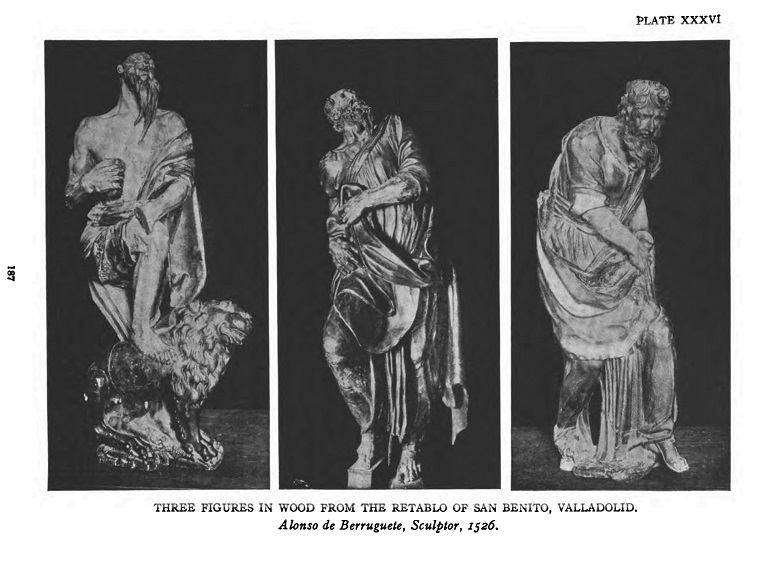Alonso Berruguete
Alonso González de Berruguete (c. 1488 – 1561) was a Spanish painter, sculptor and architect. He is considered to be the most important sculptor of the Spanish Renaissance, and is known for his emotive sculptures depicting religious ecstasy or torment.[1]
Born in the town of
Berruguete returned to Spain in 1517, and in 1518, was appointed to the position of court painter and sculptor by Charles V of Spain, who gave him much work to do at Madrid, at the Palace of El Pardo, and at the Alhambra.[2] He carved the relief of the Resurrection in Valencia Cathedral. Because he did not follow the emperor to Germany in 1520, however, he received no royal commissions for paintings. From this point in his career forward, Berruguete concentrated primarily on sculpture.[4] In 1519 he collaborated with Felipe Bigarny on the tomb of Cardinal Juan Selvagio in the Church of Santa Engracia de Zaragoza.
Works of his include an altarpiece at the
Wood sculpture
After his training in Italy he went back to the Spanish tradition of making wood sculptures, which included the altarpieces at the church of San Benito el Real, Valladolid. "The exaggerated movements of his figures became a mannerism with his followers Andrés de Nájera, Esteban Jordán, Inocencio Berruguete and others..."[1]
From October 13, 2019 – February 17, 2020, over 40 of Berruguete's painted wood sculptures were on display in the National Gallery of Art, Washington, D.C. as part of an exhibition titled Alonso Berruguette: First Sculptor of Renaissance Spain.[5]
References
- ^ a b c d Arthur Byne; Mildred Stapley Byne (1917). Spanish Architecture of the Sixteenth Century. G. P. Putnam's sons. pp. 186–.
- ^ a b c Van Cleef, Augustus. "Alonso Berruguete." The Catholic Encyclopedia Vol. 2. New York: Robert Appleton Company, 1907
 This article incorporates text from this source, which is in the public domain.
This article incorporates text from this source, which is in the public domain.
- ^ a b Sturgis, Russell (1901). A Dictionary of Architecture and Building, Volume I. Macmillan. pp. 296–297.
- ^ Britannica, The Editors of Encyclopaedia. "Alonso Berruguete". Encyclopedia Britannica, 11 August 2023
- ^ "Alonso Berruguete: First Sculptor of Renaissance Spain". National Gallery of Art. Retrieved September 28, 2020.
![]() This article incorporates text from a publication now in the public domain: Herbermann, Charles, ed. (1913). "Alonso Berruguete". Catholic Encyclopedia. New York: Robert Appleton Company.
This article incorporates text from a publication now in the public domain: Herbermann, Charles, ed. (1913). "Alonso Berruguete". Catholic Encyclopedia. New York: Robert Appleton Company.
External links
![]() Media related to Alonso Berruguete at Wikimedia Commons
Media related to Alonso Berruguete at Wikimedia Commons

